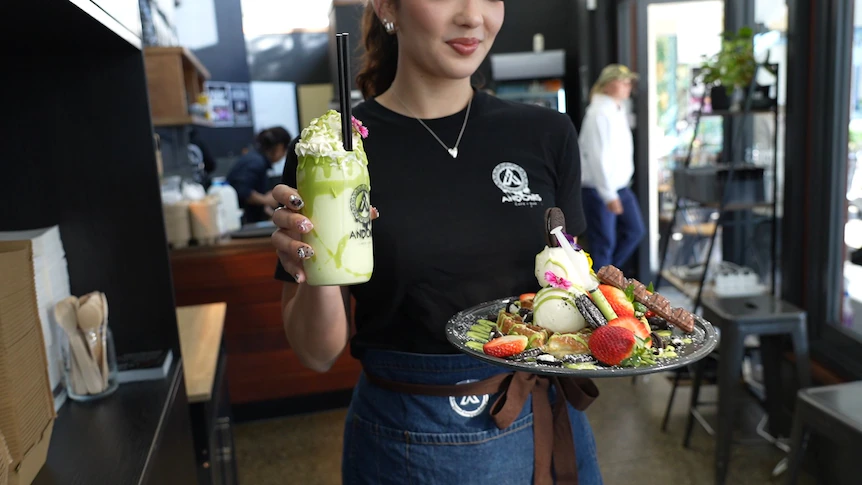By Liana Walker
Copyright abc

It’s a Tuesday winter morning in the Brisbane suburb of Yeerongpilly.
Long-distance friends, old work colleagues and families sit at Adonis Cafe’s outdoor tables, soaking up the sun.
The inescapable pistachio stands out on the cafe’s menu, among a large offering of Instagram-able food and drink.
The bright green nut has found its way onto menus worldwide and is hyped as a must-try across social media.
So, how did pistachios suddenly rise in popularity? Will they just be replaced by the next fad in six months? And what is the next big thing?
They’re the, questions Adonis owner Anthony Kekkou constantly asks.
A trip to Dubai
Four years ago, halfway across the world, Sarah Hamouda was pregnant with her second child when an insatiable craving hit.
Fortunately, the Dubai-based mother is a food scientist.
Hamouda told the wine, food and travel publication, she wanted a chocolate bar with different textures and flavours that offered a satisfying and rich experience.
So was born the first Dubai Chocolate: a milk chocolate bar filled with pistachio-tahini cream and chopped filo-pastry kadayif.
Hamouda’s chocolate, titled “Can’t Get Knafeh of It” is near impossible to get a hold of.
Its limited supply can only be purchased during a two-hour window via a delivery app, and despite its 68.25 Emirati Dirham ($28.13) price, the bar almost always sells.
About this time, Adonis owner Kekkou was travelling through Dubai, searching for the next big thing.
“As opposed to us, while we’re still on the global platform and we’re looking for new ideas.”
When a TikTok video of an influencer showing off the colourful chocolate’s bright green insides went viral, Kekkou knew pistachios were it.
While social media can be a trend indicator, it’s not the only gauge.
Art and science
Back in Australia, Amanda Spry lectures in marketing at Melbourne’s RMIT University.
The rise of pistachios is high on the academic’s radar.
“It’s a bit of a mix of art and science, of culture and data,” Spry explains.
“Experts would certainly be looking at things like global food innovation, flavour trend reports, retail sales data and cultural and consumer behaviour shift.
Generative AI, social media tags and search trends help guide marketers.
Globally, searches for pistachios began to rise in 2021 — the same time Dubai chocolate was created — and peaked again in late 2023.
Like fashion, food trends can be cyclical, seasonal, and follow both high-end and street style taste-makers.
Spry says social media connects what is in vogue to the masses.
“If you want to get onto a trend now … that doesn’t have to necessarily be a pistachio dessert at the most high-end, premium restaurant in Melbourne, it could be a pistachio croissant at your local cafe,” she says.
But by making pistachios so prominent in the market, it’s started to make them harder to get.
Pistachio growth
The gentle sounds of water flowing down Wakool River hum in the background of Chris Joyce’s Kyalite pistachio farm on the New South Wales side of the Murray River.
To the untrained eye, the bare orchard trees may look close to death, but it is going through a chill period; about 1,000 hours below 7 degrees in the winter months.
“You need very, very hot summers, very cold winters and access to water and little rain in particular in February, March during the harvest period,” Joyce says.
This year Joyce is expecting a big harvest from the biennial bearing trees. And he will need it to keep up with demand.
Collectively, Australian pistachio growers are expecting to harvest 5,000 tonnes this year, just meeting Australia’s expected consumption.
“Up until now, the total demand in Australia has been supplemented with imports,” Joyce says.
Pistachios are sold in two forms: in shell or kernels.
Kernels have seen a massive spike in demand, increasing 40 per cent in the past six months, while shells remain steady, Joyce says.
He says it is clearly connected to the hype around the nut, as kernels are predominantly used by the food service industry for their aesthetic.
While there is sales growth in kernels, the volumes are not substantial, and the price of in-shell remains far more profitable for growers.
“Personally, I think Dubai chocolates are sort of like striped toothpaste — it’s a fad,” Joyce says.
He’s not the only one questioning the pistachio’s staying power.
Fads or trends?
Back in Brisbane, it is food futurist Tony Hunter’s job to answer that question.
Hunter works with some of the largest global brands, including KFC and Pepsico, to stay ahead of trends.
“We have to separate our fads and trends,” Hunter says.
Popular spices can be fads that emerge from the wider trend of more flavoursome food.
Likewise, pistachios are a fad that has emerged from the trend of indulgence — or little treat culture.
Knowing what the next thing is requires a lot of research, including reading industry newsletters on everything from ingredients to food technology, watching flavours transcend across food and drink and observing new businesses.
“If I see one thing that’s, Oh, that’s interesting. I see it twice, three times. Then I’m going, ‘OK, this is now,'” he says.
Hunter expects the next big thing will be a focus on fibre, feeding into the overall trend around wellness.
It’s an example of a trend emerging out of something that is already trending.
When your product is the trend
Thursday afternoon in the Gold Coast’s Robina shopping centre, Oliver Allis is surrounded by the chatter of friends catching up under a pumping stereo.
“We’re busier than the pub,” Allis jokes.
The brand director for Yo-Chi knows better than most about trend emergence; its main product, frozen yoghurt, is vulnerable to the trend cycle.
To extend Yo-Chi’s longevity, Allis looks to capitalise on other trends that it can integrate into its business model — like pistachios — a strategy that has helped the brand become a taste maker.
A collaboration with Pistachio Papi spread was an obvious choice.
“We didn’t know it was going to be as huge as it was,” Allis says.
“Some people might say that Yo-Chi helped them get to that mass appeal by [doing] such a large marketing campaign.”
To maintain taste-maker status, Allis must be tapped into the next big thing.
Research is done on social media and in person. From seeing what tags are popular on TikTok to visiting a new dessert bar in a hip suburb and talking to people around them.
“You can’t force these things. If you force it, that’s when you don’t get the gold or the right flavour or right topping, or right collaboration,” Allis says.
Coming up, Allis says Yo-Chi is looking at ube, a bright purple Filipino sweet potato, yuzu — an East-Asian citrus fruit, Australian natives, and even edible cutlery.
When a trend dies
Like Allis, Kekkou works to stay ahead of the curve.
“We’ve always been on the lookout for global trends and we like to roll them out, introduce them first,” Kekkou says.
Part of that is knowing when a trend has come to an end.
Hunter says there’s no real time frame, but he suspects the pistachio fad will come to an end within the next 12 months.
“What we’re finding now is there’s a bit of a pistachio overload,” Kekkou says.
“I think people are starting to get a little bit bored of it as well.
“So I think now is the time to start looking at the next trend or try to introduce the next trend.”
For Allis, there’s one key indicator that a trend is done



